中文论文范文MLA格式关于XX论文mla格式问题
mla中文参考文献格式

mla中文参考文献格式MLA格式是一种常用的学术论文引用格式,适用于人文学科的研究论文。
以下是MLA中文参考文献格式的写作要求和一些相关参考内容:一、书籍的引用格式:作者姓,名。
题名。
出版地:出版社,出版年。
印刷。
例如:王小波。
黄金时代。
北京:北京十月文艺出版社,2007。
印刷。
二、诗歌或短篇小说的引用格式:作者姓,名。
"诗歌或短篇小说标题." 集合名,编辑姓,名。
出版地:出版社,出版年。
印刷。
例如:余光中。
"乡愁"。
闻一多诗选,李镜莲编。
北京:人民文学出版社,1986。
印刷。
三、期刊文章的引用格式:作者姓,名。
"文章标题." 期刊名,卷号.号码(年):页码。
例如:李天命。
"诗与心灵的飨宴." 中国文学研究,第30卷第4期(2005):94-98。
四、网页的引用格式:作者(如果有的话)。
"文章标题." 网站标题(斜体),出版日期(如果有的话)。
例如:李白。
"静夜思." 古诗文网(斜体),2009年。
五、电影的引用格式:电影名。
导演名。
演员名。
出品公司,年份。
例如:《活着》。
张艺谋。
葛优,巩俐。
北京新亚洲影视传媒有限公司,1994。
以上是MLA中文参考文献格式的一些常见写作要求和示例。
写作时需要依据提供的信息填写相应的内容,确保格式正确。
另外,还需要注意参考文献列表末尾的字母排序和缩进等细节。
建议在参考文献的写作过程中参考MLA手册或询问导师或咨询学术写作中心,以确保准确无误。
毕业论文文献引用规范MLA格式详解
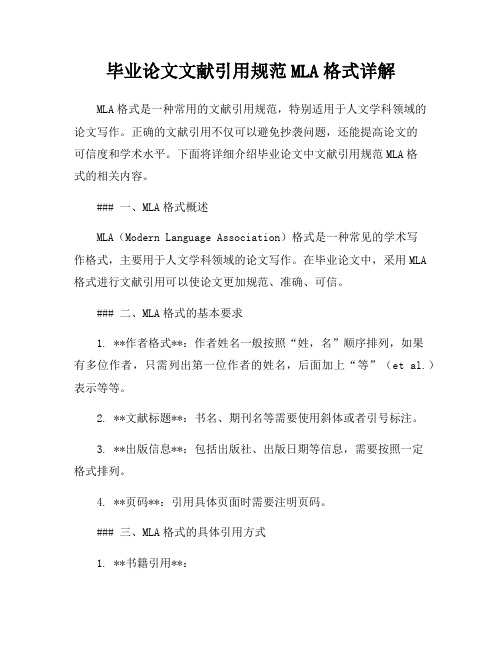
毕业论文文献引用规范MLA格式详解MLA格式是一种常用的文献引用规范,特别适用于人文学科领域的论文写作。
正确的文献引用不仅可以避免抄袭问题,还能提高论文的可信度和学术水平。
下面将详细介绍毕业论文中文献引用规范MLA格式的相关内容。
### 一、MLA格式概述MLA(Modern Language Association)格式是一种常见的学术写作格式,主要用于人文学科领域的论文写作。
在毕业论文中,采用MLA 格式进行文献引用可以使论文更加规范、准确、可信。
### 二、MLA格式的基本要求1. **作者格式**:作者姓名一般按照“姓,名”顺序排列,如果有多位作者,只需列出第一位作者的姓名,后面加上“等”(et al.)表示等等。
2. **文献标题**:书名、期刊名等需要使用斜体或者引号标注。
3. **出版信息**:包括出版社、出版日期等信息,需要按照一定格式排列。
4. **页码**:引用具体页面时需要注明页码。
### 三、MLA格式的具体引用方式1. **书籍引用**:- 书籍作者格式:作者姓,名。
书名。
出版地:出版社,出版年。
- 书籍引用示例:Smith, John. *The Art of Writing*. New York: ABC Publishing, 2021.2. **期刊文章引用**:- 期刊作者格式:作者姓,名。
“文章标题”。
期刊名,卷号,期号,出版年,页码。
- 期刊文章引用示例:Brown, Sarah. “The Impact of Technology on Education”. *Journa l of Education*, vol. 25, no. 2, 2019, pp. 45-56.3. **网页引用**:- 网页作者格式:作者姓,名(如果有)。
“文章标题”。
网站名,发布日期,URL。
- 网页引用示例:Johnson, Michael. “The Future ofArtificial Intelligence”. *Tech News*, 10 May 2020,/future-ai.### 四、MLA格式的注意事项1. 引用时要注意标点符号、斜体、引号等格式的使用,确保引用信息清晰明了。
MLA 格式论文范文
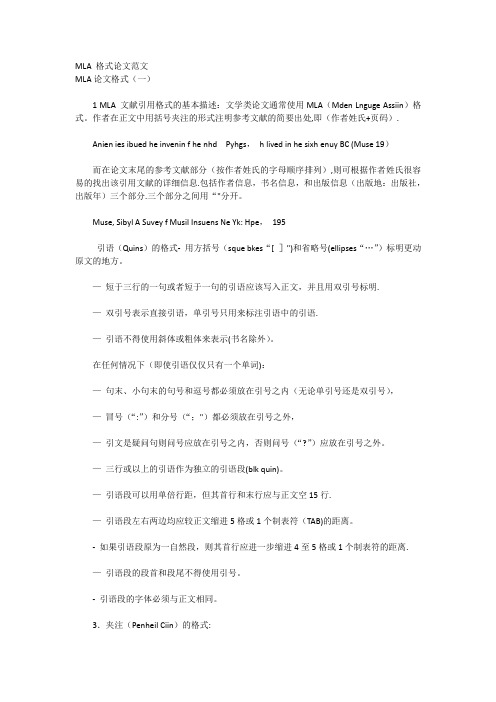
MLA 格式论文范文MLA论文格式(一)1 MLA 文献引用格式的基本描述:文学类论文通常使用MLA(Mden Lnguge Assiin)格式。
作者在正文中用括号夹注的形式注明参考文献的简要出处,即(作者姓氏+页码).Anien ies ibued he invenin f he nhd Pyhgs,h lived in he sixh enuy BC (Muse 19)而在论文末尾的参考文献部分(按作者姓氏的字母顺序排列),则可根据作者姓氏很容易的找出该引用文献的详细信息.包括作者信息,书名信息,和出版信息(出版地:出版社,出版年)三个部分.三个部分之间用“"分开。
Muse, Sibyl A Suvey f Musil Insuens Ne Yk: Hpe,195引语(Quins)的格式- 用方括号(sque bkes“[ ]")和省略号(ellipses“…”)标明更动原文的地方。
—短于三行的一句或者短于一句的引语应该写入正文,并且用双引号标明.—双引号表示直接引语,单引号只用来标注引语中的引语.—引语不得使用斜体或粗体来表示(书名除外)。
在任何情况下(即使引语仅仅只有一个单词):—句末、小句末的句号和逗号都必须放在引号之内(无论单引号还是双引号),—冒号(“:”)和分号(“;")都必须放在引号之外,—引文是疑问句则问号应放在引号之内,否则问号(“?”)应放在引号之外。
—三行或以上的引语作为独立的引语段(blk quin)。
—引语段可以用单倍行距,但其首行和末行应与正文空15行.—引语段左右两边均应较正文缩进5格或1个制表符(TAB)的距离。
- 如果引语段原为一自然段,则其首行应进一步缩进4至5格或1个制表符的距离.—引语段的段首和段尾不得使用引号。
- 引语段的字体必须与正文相同。
3.夹注(Penheil Ciin)的格式:引文出处使用括号夹注的方法(一般不使用脚注或者尾注)。
mla格式引用硕士文献
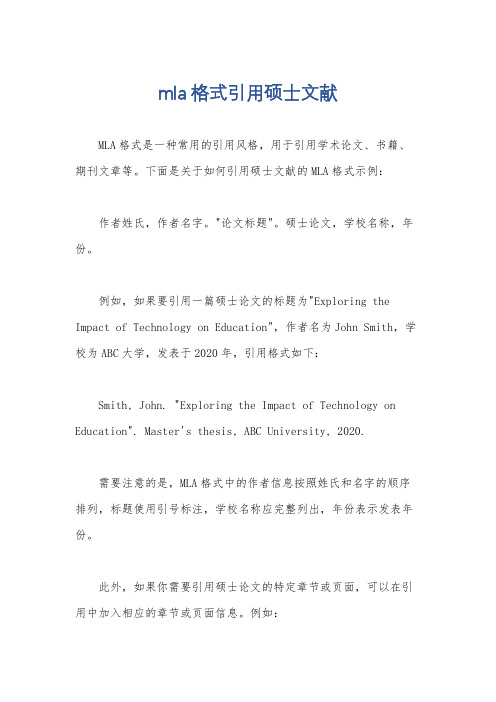
mla格式引用硕士文献
MLA格式是一种常用的引用风格,用于引用学术论文、书籍、期刊文章等。
下面是关于如何引用硕士文献的MLA格式示例:
作者姓氏,作者名字。
"论文标题"。
硕士论文,学校名称,年份。
例如,如果要引用一篇硕士论文的标题为"Exploring the Impact of Technology on Education",作者名为John Smith,学校为ABC大学,发表于2020年,引用格式如下:
Smith, John. "Exploring the Impact of Technology on Education". Master's thesis, ABC University, 2020.
需要注意的是,MLA格式中的作者信息按照姓氏和名字的顺序排列,标题使用引号标注,学校名称应完整列出,年份表示发表年份。
此外,如果你需要引用硕士论文的特定章节或页面,可以在引用中加入相应的章节或页面信息。
例如:
Smith, John. "Exploring the Impact of Technology on Education". Master's thesis, ABC University, 2020, pp. 35-45.
上述示例中的"pp."表示页面范围,35-45表示引用的页面。
希望以上MLA格式引用硕士文献的示例能对你有所帮助。
如有其他问题,请随时提问。
mla格式中文范文举例
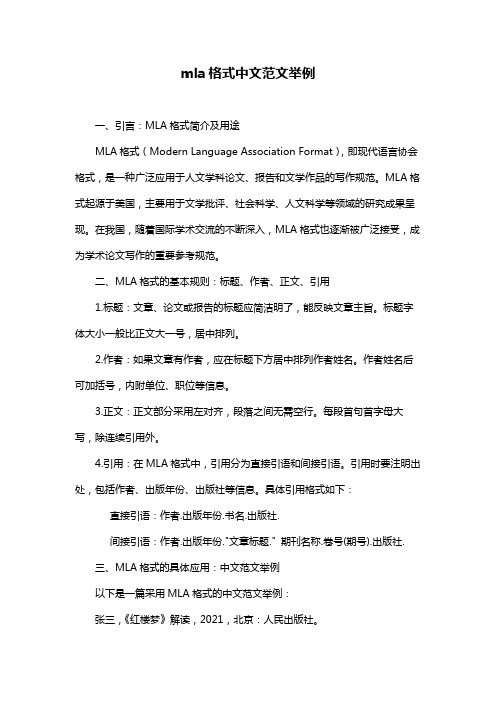
mla格式中文范文举例一、引言:MLA格式简介及用途MLA格式(Modern Language Association Format),即现代语言协会格式,是一种广泛应用于人文学科论文、报告和文学作品的写作规范。
MLA格式起源于美国,主要用于文学批评、社会科学、人文科学等领域的研究成果呈现。
在我国,随着国际学术交流的不断深入,MLA格式也逐渐被广泛接受,成为学术论文写作的重要参考规范。
二、MLA格式的基本规则:标题、作者、正文、引用1.标题:文章、论文或报告的标题应简洁明了,能反映文章主旨。
标题字体大小一般比正文大一号,居中排列。
2.作者:如果文章有作者,应在标题下方居中排列作者姓名。
作者姓名后可加括号,内附单位、职位等信息。
3.正文:正文部分采用左对齐,段落之间无需空行。
每段首句首字母大写,除连续引用外。
4.引用:在MLA格式中,引用分为直接引语和间接引语。
引用时要注明出处,包括作者、出版年份、出版社等信息。
具体引用格式如下:直接引语:作者.出版年份.书名.出版社.间接引语:作者.出版年份."文章标题." 期刊名称.卷号(期号).出版社.三、MLA格式的具体应用:中文范文举例以下是一篇采用MLA格式的中文范文举例:张三,《红楼梦》解读,2021,北京:人民出版社。
在这本书中,张三对《红楼梦》进行了深入解读,分析了作品中的主题、情节、人物关系等。
书中指出,《红楼梦》是一部具有深刻内涵和丰富文化内涵的作品,作者曹雪芹通过讲述贾宝玉、林黛玉等人的故事,反映了当时社会的风俗、道德观念及家族衰落的历史变迁。
四、MLA格式中引用的注意事项1.引用要准确:确保引用的信息与原文一致,避免误导读者。
2.引用格式规范:遵循MLA格式的引用规范,统一格式。
3.引文标注清晰:在文章中引用他人观点或研究成果时,要注明出处,以便读者查阅。
4.适当引用:避免过度引用,以免影响文章的可读性和原创性。
五、结论:MLA格式在中文写作中的实用性MLA格式作为一种国际通用的写作规范,在我国中文写作领域的应用越来越广泛。
mla中文参考文献格式
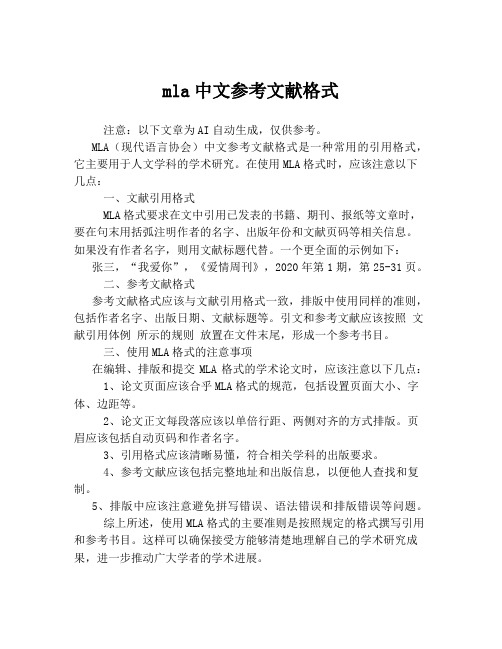
mla中文参考文献格式
注意:以下文章为AI自动生成,仅供参考。
MLA(现代语言协会)中文参考文献格式是一种常用的引用格式,它主要用于人文学科的学术研究。
在使用MLA格式时,应该注意以下几点:
一、文献引用格式
MLA格式要求在文中引用已发表的书籍、期刊、报纸等文章时,要在句末用括弧注明作者的名字、出版年份和文献页码等相关信息。
如果没有作者名字,则用文献标题代替。
一个更全面的示例如下:张三,“我爱你”,《爱情周刊》,2020年第1期,第25-31页。
二、参考文献格式
参考文献格式应该与文献引用格式一致,排版中使用同样的准则,包括作者名字、出版日期、文献标题等。
引文和参考文献应该按照文献引用体例所示的规则放置在文件末尾,形成一个参考书目。
三、使用MLA格式的注意事项
在编辑、排版和提交MLA格式的学术论文时,应该注意以下几点:
1、论文页面应该合乎MLA格式的规范,包括设置页面大小、字体、边距等。
2、论文正文每段落应该以单倍行距、两侧对齐的方式排版。
页眉应该包括自动页码和作者名字。
3、引用格式应该清晰易懂,符合相关学科的出版要求。
4、参考文献应该包括完整地址和出版信息,以便他人查找和复制。
5、排版中应该注意避免拼写错误、语法错误和排版错误等问题。
综上所述,使用MLA格式的主要准则是按照规定的格式撰写引用和参考书目。
这样可以确保接受方能够清楚地理解自己的学术研究成果,进一步推动广大学者的学术进展。
mla论文格式范文
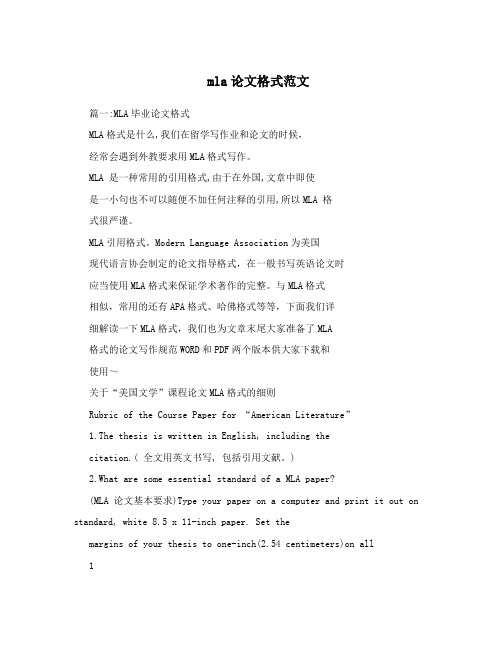
mla论文格式范文篇一:MLA毕业论文格式MLA格式是什么,我们在留学写作业和论文的时候,经常会遇到外教要求用MLA格式写作。
MLA 是一种常用的引用格式,由于在外国,文章中即使是一小句也不可以随便不加任何注释的引用,所以MLA 格式很严谨。
MLA引用格式。
Modern Language Association为美国现代语言协会制定的论文指导格式,在一般书写英语论文时应当使用MLA格式来保证学术著作的完整。
与MLA格式相似,常用的还有APA格式、哈佛格式等等,下面我们详细解读一下MLA格式,我们也为文章末尾大家准备了MLA格式的论文写作规范WORD和PDF两个版本供大家下载和使用~关于“美国文学”课程论文MLA格式的细则Rubric of the Course Paper for “American Literature”1.The thesis is written in English, including thecitation.( 全文用英文书写, 包括引用文献。
)2.What are some essential standard of a MLA paper?(MLA 论文基本要求)Type your paper on a computer and print it out on standard, white 8.5 x 11-inch paper. Set themargins of your thesis to one-inch(2.54 centimeters)on all1sides. The paper should be double-space typed. There is one space between every English words. There is no space between the words and punctuations. (用12号新罗马字体排版,双倍行距。
MLA正文格式样例
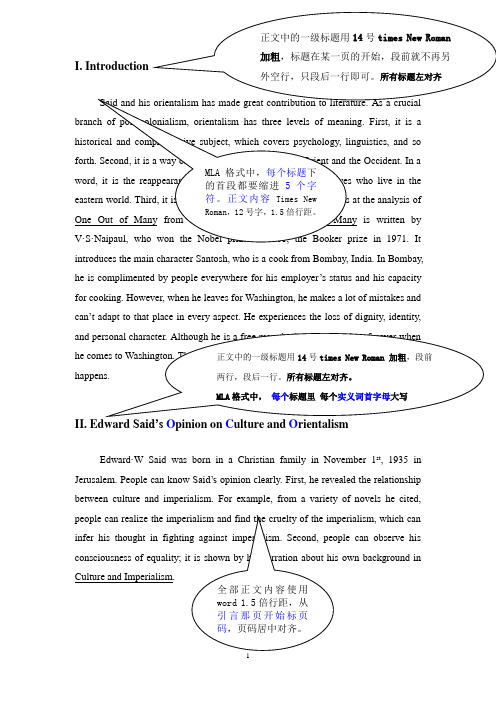
introduces the main character Santosh, who is a cook from Bombay, India. In Bombay, he is complimented by people everywhere for his employer ’s status and his capacity for cooking. However, when he leaves for Washington, he makes a lot of mistakes and can ’t adapt to that place in every aspect. He experiences the loss of dignity, identity, II. Edward Said’s O pinion on C ulture and O rientalismEdward·W Said was born in a Christian family in November 1st , 1935 in Jerusalem. People can know Said’s opinion clearly. First, he revealed the relationship between culture and imperialism. For example, from a variety of novels he cited, infer his thought in can observe his Culture and Imperialism.Although the western people think that the eastern world is backward and the My a political doctrinewilled over than the West, which elided a cultural and Said has studied What ’s more, he is Said’s work also has clear politicaldescribes various degrees.C. Said’s C riticism of O rientalismOrientalism is a book published in 1978 by Edward Said that has been highly influential and controversial in post-colonial studies and other fields. In the book, heⅢ. The Analysis ofPerspectiveThe above chapter has introduced what is orientalism and Said’s attitude towards orientalism. This chapter aims at analyzing One Out of Many from Said’s orientalism perspective. The main character of One Out of Many is Santosh. He is a cook in Bombay, India. 后几段已省略A. The Reappearance of Orientalism and Its Analysis of One Out of ManyClaiming to be a citizen of the world, V·S·Naipaul is one of the most famous writer in Britain who is awarded the Nobel Prize for literature in 2001. 后几段已省2. The Loss of IdentityAlthough the Washington people show contemplation to Santosh, he doesn’t abandon the pursuit for freedom. He makes great efforts to make him adapt to the life in Washington. First, He buys a green suit and he decides to not tell his employer.以后部分省略当文中出现两个作者共同写的一本书时,格式如下:In the 1970s the Great Pyramid inspired a fad of pyramid enthusiasts, who . . . (Schul and Pettit 159). 或者Schul and Pettit draw attention to the fact that in the 1970s the Great Pyramid . . . (159).如作者姓名在文中出现,在括号中只写页码。
mla中文论文格式
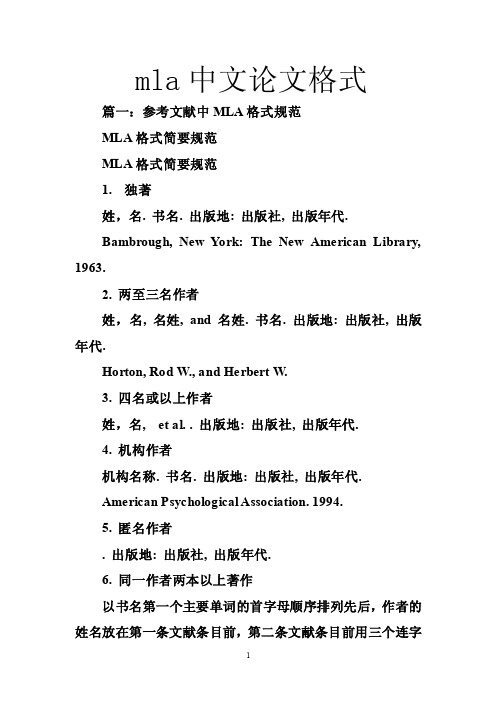
mla中文论文格式篇一:参考文献中MLA格式规范MLA格式简要规范MLA格式简要规范1. 独著姓,名. 书名. 出版地: 出版社, 出版年代.Bambrough, New York: The New American Library, 1963.2. 两至三名作者姓,名, 名姓, and 名姓. 书名. 出版地: 出版社, 出版年代.Horton, Rod W., and Herbert W.3. 四名或以上作者姓,名, et al. . 出版地: 出版社, 出版年代.4. 机构作者机构名称. 书名. 出版地: 出版社, 出版年代.American Psychological Association. 1994.5. 匿名作者. 出版地: 出版社, 出版年代.6. 同一作者两本以上著作以书名第一个主要单词的首字母顺序排列先后,作者的姓名放在第一条文献条目前,第二条文献条目前用三个连字号。
Bloom, Harold. New York: Oxford University Press, 1973.7. 编著一名编者:姓, 名, ed. . 出版地: 出版社, 出版年.Frye, Northrop, ed. New York: Columbia University Press, 1963.两名编者:姓, 名, and 名姓, eds. . 出版地: 出版社, 出版年.三名以上的编者:第一编者姓, 名, et al. 出版地: 出版社, 出版年. University Press, 1986.8. 译著原作者姓, 名. 译者名姓. 出版地: 出版社, 出版年. Norton, 1961.9. 再版著作姓,名. 版别序号ed. 出版地: 出版社, 出版年代.Fromkin, Victoria, and Robert Rodman. 5th ed. Ft. Worth: Harcourt, 1993.10. 论文集中的文章文章作者姓, 名. “文章标题.” . Ed. 论文集编者名姓.出版地: 出版社, 出版年代. 起始页码.Wellek, Rene. “Romanticism RE-examined.”Ed. Northrop Frye. New York: Columbia University Press, 1963. 75-98.Hall, Stuart, “Minial Selves.”Arnold: Hodder Headline Group, 1993. 131-42.11. 多卷或多册著作,书名后注明第几册或第几卷.姓, 名. 书名. 卷目vols. (其他信息). 出版地: 出版社, 出版年代.Plato. 2 vols. Trans. R. G. Bury. Leob Classical Libery. New York: G. P. Putnam's Sons, 1926.12. 前言,后记前言作者姓,名. “Introduction (或Forewords 或Preface).”书名. By 书目作者名姓. 出版地: 出版社, 出版年代. 前言起始页码.后记作者姓,名. “Afterwords.”书名. By 书目作者名姓. 出版地: 出版社, 出版年代. 后记起始页码.Schlesinger, Arthur M., Jr. “Introduction.”13. 期刊文章文章作者姓, 名. “文章标题.”卷号. 期号(出版年代): 起始页码.Maguire, James H. “The Canon and the'Diminished Thing.”(1988): 645-52.Davis, Sherri Heckler. “The Zen Art of Prewriting.”1 (1988): 21-23.14. 周刊或双周刊文章文章作者姓, 名. “文章标题.”出版日月年: 起始页码.Hoagland, Edward. “Standing T ough in the Desert.”May 1989: 44-45.15. 月刊或双月刊文章文章作者姓, 名. “文章标题.”出版月年: 起始页码. January 1994: 37-56.16. 报纸文章文章作者姓, 名. “文章标题.”出版日月年, 版, 栏, 页码.Intraub, Anna Jinagwang. “How I learned to Read.”13 January 2002, Section 4, Column 6, Page 16.如果作者未知, 版栏信息缺失, 格式为:“文章标题.”报纸名称出版日月年: 页码.“Learn English through Football.”17. 网络著作作者姓, 名. 出版年代. 检索日月年<详细网址>.Emerson, Ralph Waldo. 1841. 12 February 1997.</essays1.htm>18. 网络文章作者姓, 名. 来源名称). 发表日月年. 检索日月年<详细网址>. Fischer, Michael F. “.”21 November 2005.8 May 2007. < /~wwftd/>.19. CD-ROM作者姓, 名. “条目标题.”其他信息). CD-ROM. 出版地: 出版社, 出版年代.“Communion.”2nd ed. CD-ROM. Oxford: Oxford UP, 1992.汉语参考书目专著格式:编著者.书名[M],出版地:出版社,年代,起止页码.孙家广,杨长青. 计算机图形学[M]. 北京:清华大学出版社,1995, 26-28.期刊论文格式:作者.论文名称[J],期刊名称,年度,卷(期):起止页码.李旭东,宗光华,毕树生,等. 生物工程微操作机器人视觉系统的研究[J]. 北京航空航天大学学报,2002,28(3):249-252.周星.中国艺术教育基本状况与学科发展[J].艺术教育,2007(2):4-5.会议文献格式:作者1,作者2,作者3等.文章题目名[A].见:主编. 论文集名[C].出版地:出版社,年代.起止页码.张佐光,张晓宏,仲伟虹,等. 多相混杂纤维复合材料拉伸行为分析[A].见:张为民编. 第九届全国复合材料学术会议论文集(下册) [C].北京:世界图书出篇二:MLA引用文献规范MLA论文格式1. MLA 文献引用格式的基本描述:文学类论文通常使用MLA(Modern Language Association)格式。
mla引用格式例子

mla引用格式例子MLA(Modern Language Association)引用格式是一种常见的学术引用格式,主要用于人文学科的论文。
以下是一个MLA引用格式的例子:假设我们要引用一篇名为“The Rise of the Creative Class”的文章,作者为Richard Florida。
1. 在文中引用:Richard Florida posits that the rise of the creative class has transformed the economic and cultural landscape of many cities.2. 在文末引用:Richard Florida, “The Rise of the Creative Class,” in The New Geography of Cities (New York: Basic Books, 2002), .注意,MLA格式要求在引文后面提供页码范围,如果引文出现在一页的中间,则提供该页的页码。
例如:3. 在文中引用特定段落:According to Richard Flo rida (123), “the rise of the creative class has had profound impacts on urban development.”4. 在文末引用特定段落:Richard Florida, “The Rise of the Creative Class,” in The New Geography of Cities (New York: Basic Books, 2002), , 130.此外,如果文章是由多人合作完成的,应将所有作者的名字都列出来,用逗号隔开。
例如:5. 在文中引用多位作者:Recent studies by Smith, Johnson, and Davis have shown that the creative class has had a significant impact on urban development.6. 在文末引用多位作者:Smith, Johnson, and Davis, “The Impact of the Creative Class on Urban Development,” in The New Geography of Cities, ed. Smith et al. (New York: Basic Books, 2002), , 130.。
mla格式参考文献模板中文

mla格式参考文献模板中文MLA格式是一种常用的参考文献格式,在学术论文、专业报告等文献中都有广泛的应用。
本文将提供一个简单易用的MLA格式参考文献模板,用于帮助读者更好地完成他们的学术写作。
步骤1:开头在计算机上打开新的文档,并设置页面格式为适当的大小和边距。
然后输入以下信息:作者姓名,不需要使用逗号,将其与论文中的其他作者分开即可。
如果您是唯一作者,则只需输入您的姓名。
论文的标题。
请务必将标题用双引号括起来,并将其设为14号字体和粗体。
学术机构名称,位于论文的最后一行。
其中应包括您的大学、系所和所在城市的名称。
示例:陈小明“自然灾害与人类生存”清华大学,北京市步骤2:正文在标题下方两行,开始输入正文。
按照MLA格式,每段之间应有一个空行,并缩进五个字符的空格。
请记住,您必须在使用任何引用之前创建一个正文。
除非在引用时引用的是同一位作者的多个文章,在此情况下,您可以在引用之前包括其所有参考文献。
步骤3:引用在引用中,请务必提供足够的信息以使读者能够查找并阅读源。
每篇引用应使用逗号分隔,引用作者的名字,然后将其引用于文章中的字数。
引用所在书的名称和编辑(如果有的话),出版日期和出版商的标识。
示例:沈从文,“白毛女”,《沉淀》,北京:北京出版社,2003年,第126页。
步骤4:结论在您的论文的结尾或总结中,总结您的主要主张并提供一个总结。
请不要简单地重复您的正文中的结论,而是通过进一步解释和对论点的重点强调,进一步证明您的论点的可信度。
步骤5:参考文献最后一部分是参考文献列表,它应包含您在正文中引用的所有书籍、文章和其他来源的完整信息。
每个条目应以作者的姓氏为主,也可以在副本中包括名称和日期。
示例:沈从文。
《沉淀》。
北京出版社,2003。
总结通过本文提供的步骤,您可以轻松地创建一个适当的MLA格式参考文献。
请记住,在在写学术论文时,始终需要学习并遵守常用的参考文献格式,以保证研究的可信度和可视性。
mla格式 引用 -回复
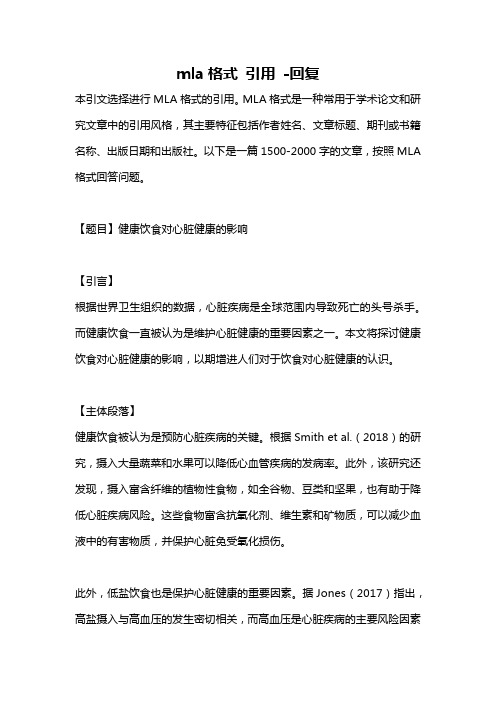
mla格式引用-回复本引文选择进行MLA格式的引用。
MLA格式是一种常用于学术论文和研究文章中的引用风格,其主要特征包括作者姓名、文章标题、期刊或书籍名称、出版日期和出版社。
以下是一篇1500-2000字的文章,按照MLA 格式回答问题。
【题目】健康饮食对心脏健康的影响【引言】根据世界卫生组织的数据,心脏疾病是全球范围内导致死亡的头号杀手。
而健康饮食一直被认为是维护心脏健康的重要因素之一。
本文将探讨健康饮食对心脏健康的影响,以期增进人们对于饮食对心脏健康的认识。
【主体段落】健康饮食被认为是预防心脏疾病的关键。
根据Smith et al.(2018)的研究,摄入大量蔬菜和水果可以降低心血管疾病的发病率。
此外,该研究还发现,摄入富含纤维的植物性食物,如全谷物、豆类和坚果,也有助于降低心脏疾病风险。
这些食物富含抗氧化剂、维生素和矿物质,可以减少血液中的有害物质,并保护心脏免受氧化损伤。
此外,低盐饮食也是保护心脏健康的重要因素。
据Jones(2017)指出,高盐摄入与高血压的发生密切相关,而高血压是心脏疾病的主要风险因素之一。
因此,减少食用加工食品和咸味零食,限制食盐的摄入量,对预防心脏疾病尤为重要。
此外,Omega-3脂肪酸也被广泛认为对心脏健康有益。
根据Rios-Hoyo 和Vixens(2018)的研究,人们可以从鱼类、坚果和亚麻籽等食物中获得丰富的Omega-3。
这些脂肪酸可以降低血脂、减少炎症反应,从而降低心脏疾病风险。
研究还表明,每周摄入两次鱼类可以显著降低心脏病发作和死亡的风险。
【结论】综上所述,健康饮食对心脏健康具有重要影响。
摄入大量蔬菜、水果、全谷物和豆类等富含纤维和抗氧化剂的食物有助于预防心脏疾病。
同时,限制食盐摄入量和增加Omega-3脂肪酸的摄入也对心脏健康起到积极作用。
因此,人们应该采取积极的饮食方式,以保护心脏健康。
【参考文献】Jones, A. (2017). The impact of salt intake on heart health. Journal of Cardiology, 45(2), 115-120.Rios-Hoyo, A., & Vixens, J. (2018). Omega-3 fatty acids in cardiovascular health: An updated review. Journal of Clinical Lipidology, 12(4), 1-9.Smith, B., Johnson, C., & Anderson, D. (2018). The role of diet in heart health. Journal of Nutrition, 35(2), 65-70.。
MLA论文格式
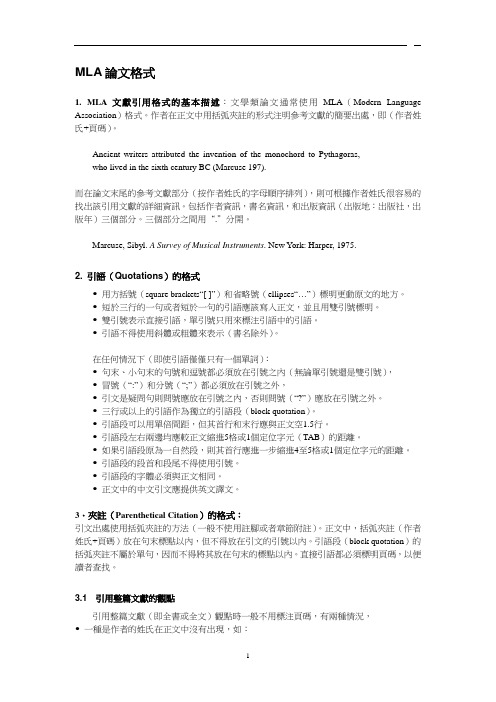
MLA論文格式1. MLA 文獻引用格式的基本描述:文學類論文通常使用MLA(Modern Language Association)格式。
作者在正文中用括弧夾註的形式注明參考文獻的簡要出處,即(作者姓氏+頁碼)。
Ancient writers attributed the invention of the monochord to Pythagoras,who lived in the sixth century BC (Marcuse 197).而在論文末尾的參考文獻部分(按作者姓氏的字母順序排列),則可根據作者姓氏很容易的找出該引用文獻的詳細資訊。
包括作者資訊,書名資訊,和出版資訊(出版地:出版社,出版年)三個部分。
三個部分之間用“.”分開。
Marcuse, Sibyl. A Survey of Musical Instruments. New York: Harper, 1975.2. 引語(Quotations)的格式用方括號(square brackets“[ ]”)和省略號(ellipses“…”)標明更動原文的地方。
短於三行的一句或者短於一句的引語應該寫入正文,並且用雙引號標明。
雙引號表示直接引語,單引號只用來標注引語中的引語。
引語不得使用斜體或粗體來表示(書名除外)。
在任何情況下(即使引語僅僅只有一個單詞):句末、小句末的句號和逗號都必須放在引號之內(無論單引號還是雙引號),冒號(“:”)和分號(“;”)都必須放在引號之外,引文是疑問句則問號應放在引號之內,否則問號(“?”)應放在引號之外。
三行或以上的引語作為獨立的引語段(block quotation)。
引語段可以用單倍間距,但其首行和末行應與正文空1.5行。
引語段左右兩邊均應較正文縮進5格或1個定位字元(TAB)的距離。
如果引語段原為一自然段,則其首行應進一步縮進4至5格或1個定位字元的距離。
引語段的段首和段尾不得使用引號。
论文MLA格式详解(参考)

论文MLA格式详解论文MLA格式详解因为学术论文的格式有严谨要求,所以也找了相关资料。
下面是我搜集整理的的针对MLA格式最详细的解说,还有举例。
MLA论文的如果句子中已经提供了作者的信息两个或三个作者,要写出每一个作者的姓:三个作者以上,可以写出每一个作者的姓,或者只写出第一个作者的姓,用 et al. 代替其余作者。
如果参考文献同一个作者的不同著作,要在作者的姓后面注明著作名称,再加页码:机构作者,用机构的全称或缩写形式:匿名作者,用文章题目的几个单词:begin s to imp ossibl s hine thr ough.以下是与文内注释相对应的论文末尾的参考文献条目:Warhol,And. Th e Philos oph of A nd Warho l. Ne Yo rk: Haro urt Brae, 1975.3. 引用文学作品小说的注释,除了页码外,最好还加上卷、章,页码后用分号。
长诗的注释要分卷、行。
戏剧的注释应标出引文的幕、场、行。
范例:如果没理由确定作者,则用书名。
文学作品的引文如果超过4行,则需要上下各空一行另成一段,第一行不缩进,英文每一行左边都缩进10个字符,中文空四格,不用引号,右边不缩进。
范例:Natureis not s impl the Not-Mebut also the uni versal m ind hose signs a re visib le for t he indiv idualt o read,ith ees, heart a nd mind.Ever m an s ond ition is a solut ion in h ieroglph i to tho se inqui ries heould put.He at s it a l ife befo re he ap prehends it as t ruth. In like ma nner,nat ure is a lread, i n its fo rms andtendenie s, desri bing its on desi gn. Letus inter rogate t he great apparit ion that shinesso peaef ull arou nd us. T hat theindividu al soulan beet he mediu m of the divinefores of Natureis at th e heartof thisbook.如果在正文里引用的诗歌为两行以上,除了引号外,每一行诗还须用左斜线分隔。
MLA格式说明(5篇)
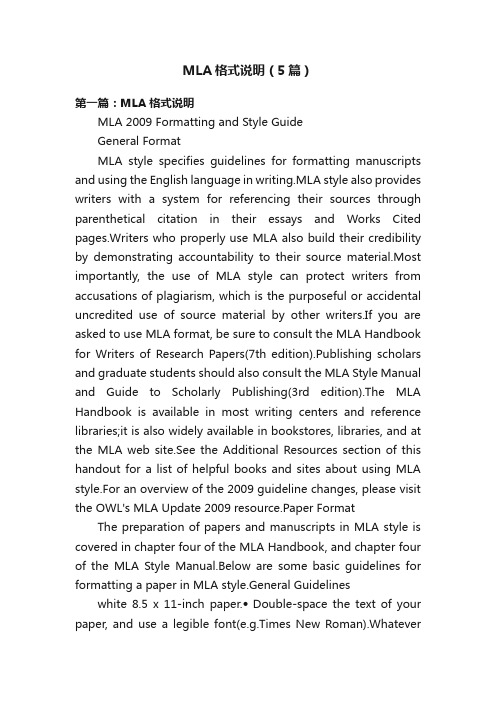
MLA格式说明(5篇)第一篇:MLA格式说明MLA 2009 Formatting and Style GuideGeneral FormatMLA style specifies guidelines for formatting manuscripts and using the English language in writing.MLA style also provides writers with a system for referencing their sources through parenthetical citation in their essays and Works Cited pages.Writers who properly use MLA also build their credibility by demonstrating accountability to their source material.Most importantly, the use of MLA style can protect writers from accusations of plagiarism, which is the purposeful or accidental uncredited use of source material by other writers.If you are asked to use MLA format, be sure to consult the MLA Handbook for Writers of Research Papers(7th edition).Publishing scholars and graduate students should also consult the MLA Style Manual and Guide to Scholarly Publishing(3rd edition).The MLA Handbook is available in most writing centers and reference libraries;it is also widely available in bookstores, libraries, and at the MLA web site.See the Additional Resources section of this handout for a list of helpful books and sites about using MLA style.For an overview of the 2009 guideline changes, please visit the OWL's MLA Update 2009 resource.Paper FormatThe preparation of papers and manuscripts in MLA style is covered in chapter four of the MLA Handbook, and chapter four of the MLA Style Manual.Below are some basic guidelines for formatting a paper in MLA style.General Guidelineswhite 8.5 x 11-inch paper.•Double-space the text of your paper, and use a legible font(e.g.Times New Roman).Whateverfont you choose, MLA recommends that the regular and italics type styles contrast enough that they are recognizable one from another.The font size should be 12 pt.• Leave only one space after periods or other punctuation marks(unless otherwise instructed by your instructor).• Set the margins of your document to 1 inch on all sides.• Indent the first line of paragraphs one half-inch from the left margin.MLA recommends that you use the T ab key as opposed to pushing the Space Bar five times.• Create a header that numbers all pages consecutively in the upper right-hand corner, one-half inch from the top and flush with the right margin.(Note: Your instructor may ask that you omit the number on your first page.Always follow your instructor's guidelines.) •Use italics throughout your essay for the titles of longer works and, only when absolutely necessary, providing emphasis.•Type your paper on a computer and print it out on standard,before your Works Cited page.Entitle the section Notes(centered, unformatted).Formatting the First Page of Your Paper • If you have any endnotes, include them on a separate pageDo not make a title page for your paper unless specifically requested.your instructor's name, the course, and the date.Again, be sure to use double-spaced text.•Double space again and center the title.Do not underline, italicize, or place your title in quotation marks;write the title in Title Case(standard capitalization), not in all capital letters.•Use quotation marks and/or italics when referring to other works in your title, just as you would in your text: Fear and Loathing in Las Vegas as Morality Play;Human Weariness in “After Apple Picking”•Double space between the title and the first line of the text.•Create a header in the upper right-hand corner thatincludes your last name, followed by a space with a page number;number all pages consecutively with Arabic numerals(1, 2, 3, 4, etc.), one-half inch from the top and flush with the right margin.(Note: Your instructor or other readers may ask that you omit last name/page number header on your first page.Always follow instructor guidelines.)Here is a sample of the top half of a first page in MLA style: A sample first page of an MLA-formatted paper.Section HeadingsWriters sometimes use Section Headings to improve a document’s readability.These sections may include individual chapters or other named parts of a book or essay.Essays MLA recommends that when you divide an essay into sections that you number those sections with an arabic number and a period followed by a space and the section name.1.Early Writings 2.The London Years 3.Traveling the Continent 4.Final YearsBooksMLA does not have a prescribed system of headings for books.If you are only using one level of headings, meaning that all of the sections are distinct and parallel and have no additional sections that fit within them, MLA recommends that these sections resemble• In the upper left-hand corner of the first page, list your name,one another grammatically.For instance, if your headings are typically short phrases, make all of the headings short phrases(and not, for example, full sentences).Otherwise, the formatting is up to you.It should, however, be consistent throughout the document.If you employ multiple levels of headings(some of your sections have sections within sections), you may want to provide a key of your chosen level headings and their formatting to your instructor or editor.Sample SectionHeadingsThe following sample headings are meant to be used only as a reference.You may employ whatever system of formatting that works best for you so long as it remains consistent throughout the document.Numbered:1.Soil Conservation 1.1 Erosion 1.2 Terracing2.Water Conservation3.Energy ConservationFormatted, unnumbered:Level 1 Heading: bold, flush leftLevel 2 Heading: italics, flush leftLevel 3 Heading: centered, boldLevel 4 Heading: centered, italics How to Cite the Purdue OWL in MLA:Entire WebsiteThe Purdue OWL.Purdue U Writing Lab, 2008.Web.27 Dec.2008.Individual ResourcesPurdue OWL.“MLA Formatting and Style Guide.” The Purdue OWL.Purdue U Writing Lab, 10 May 2008.Web.15 Nov.2008.All Sections in MLA 2009 Formatting and Style Guide:1.MLA 2009 Formatting and Style Guide2.MLA 2009 In-Text Citations: The Basics3.MLA 2009 Formatting Quotations4.MLA 2009 Footnotes and Endnotes5.MLA 2009 Works Cited Page: Basic Format6.MLA 2009 Works Cited Page: Books7.MLA 2009 Works Cited: Periodicals8.MLA 2009 Works Cited: Electronic Sources(Web Publications)9.MLA 2009 Works Cited: Other Common Sources10.MLA 2009 Additional Resources11.MLA 2009 Abbreviations12.MLA 2009 Sample Works Cited Page13.MLA 2009 Sample Papers14.MLA 2009 Tables, Figures, and Examples15.MLA 2009 PowerPoint Presentation16.MLA 2009Undergraduate Sample Paper第二篇:MLA格式Hua SuPolitical Science 101, Section009Professor Dighton M.FiddnerMarch 2010Brief Analysis of Cuban Missile CrisisI think the people who have at least a little bit concern about the world issues should know the famous Cuban Missile Crisis.It has being discussed and studied over and over again by many scientists, scholars and experts since it happened.On October 15, 1962, United States reconnaissance discovered and had photos to prove that there were missile bases being built in Cuba.“One of the most startling of the thousands of photographs---some 30,000 feet of film in all---analyzed by the President and his advisers is this one of a fully operating medium-range missile base, manned by Russian technicians and able to shoot its missiles as far into the U.S.as Norfolk or Houston “(The Pictures That Spurred Us to Act)”.The next day, the president of United States was informed and organized a group of advisors, which is called Executive Committee of the National Security Council, short for EXCOMM, to discuss how to deal with this perilous event.In Cuba at that time, the government was led by communist Fidel Castro.He was afraid that the United States would attack Cuba again after the failure of the Bay of Pigs invasion.So he agreed that Soviet Union, which was led by Nikita Khrushchev at that time, could put missiles in Cuba.Because Cuba and United States are so close to each other, the missiles in Cuba werebig threat to US.After several days of discussion, the government of Kennedy imposed a naval quarantine aroundCuba and demanded that the Soviet Union removed the missiles from Cuba.After a series of negotiations between the United States, Soviet Union and Cuba, on October 28, 1962, the crisis eased after a no-invasion agreement was reached and the Soviet Union agreed to dismantle the missiles.I think it will be best for me to explain this significant event using the interstate level of analysis and the theory of realism.Interstate level of analysis contains several categories which influence the Cuban missile crisis obviously.Power is the most apparent influence.Just like Cuban, Soviet and United States all competed and threatened each other with their military power.And between Cuba and Soviet Union, they formed an alliance against United States.During the crisis, IGOs, summit meetings, each side’s diplomacy and the bargaining happening among their negotiations all had important influences which should not be forgotten.Power is the ability to get someone to do what it would not otherwise have done(or not to do what it would have done)(Goldstein et al.).United States at that time could not stand that there is a communist country located so close to it.So a CIA trained force tried to overthrow the government of Fidel Castro on April 17, 1961.But it turned out a failure.After the Bay of Pigs invasion, Cuba found out that only by increasing its own power can it prevent another United States’ invasion.And, improvement of its military power is the best way.At that time, the biggest andstrongest communist country was Soviet Union.It possessed nuclear weapons.That was also the time when the United States and the Soviet Union were the major participants of the Cold War.They competed with each other in the fields of politics, military, economy, etc.Cuba is located only several miles awayfrom Florida.So, it would be a great threat to the United States by placing nuclear missiles on the island of Cuba and at the same time prevent the United States from starting another invasion of Cuba.Cuba agreed the nuclear missiles building is for the sake of its sovereignty, territory and organization of governing.As for the Soviet Union, the reason is its diplomatic recognition.They all did it for their own interests.During the event, in order to prevent the Soviet Union from shipping more nuclear missiles devices to Cuba, the United States blocked the sea around the island of Cuba.But, the United States actually had no right to do the quarantine.United States’ quarantine against Cuba, in my opinion, was realism.Every nation has its right to possess its weapon for defense.It is against the international law, the United Nation’s Charter and the right of passage in international wate rs.The United States’ action had implied that there is no central organizing authority in the international politics.Every entity seeks its self-interests.The United States has reported that the nuclear missiles which were being placed in Cuba were seriously offensive(The Pictures That Spurred Us to Act).So in order to keep its national security under control, the United States chose to use quarantine.And this quarantine greatly related to the power of the United States.It had strong economic and military power so that this restrict quarantine can be forced.The United Nations had noticed the possibility that the conflict between these two super powers could lead to a nuclear war which would be a huge disaster.So the United Nations was negotiating with these three nations trying to ease the tension.“The break in the crisis came on Sunday, October 28, when the Soviet Government finally agreed to dismantle its offensive weapons in Cuba and return them to the Soviet Unionsubject to United Nations’ verification”().When the United States, the Soviet Union and Cuba were negotiating with each other, there was a lot of bargaining going on between them.There were a lot of letters and communications being exchanged between Khrushchev and Kennedy:On October 23 and 24, Khrushchev sent letters to Kennedy indicatingthe deterrent nature of the missiles in Cuba and the peaceful intentions ofthe Soviet Union.On October 26, Khrushchev sent Kennedy a longrambling letter seemingly proposing that the missile installations wouldbe dismantled and personnel removed in exchange for United Statesassurances that it or its proxies would not invade Cuba.On October 27,another letter to Kennedy arrived from Khrushchev, suggesting thatmissile installations in Cuba would be dismantled if the United Statesdismantled its missile installations in Turkey(Cold War: Cuban MissileCrisis).However the United States did agree the Soviet Union to remove the Jupiter missiles in Turkey.Just at that time this agreement didn’t go public.At the same time, the United States agreed to sign an agreement that promised not to invade Cuba.Sowe can tell from the information that the Soviet Union and the United States both were bargaining about their preferredoutcomes.And the Soviet Union had achieved its two main goals.Asking the United States to remove the Jupiter missile in Turkey was for the sake of its national security;and forming an agreement which the United States would not invade Cuba was for its diplomatic recognition.Because at that time, the world media did not report the news that the United States had already agreed to remove the Jupiter missile in Turkey and, which was very obvious that the Soviet Union had already removed its missile in Cuba.In public, it seemed that the Soviet Union lost and the United States won.However in reality, they both made concessions.I basically used the theory of realism and the interstate level of analysis to explain my point of view toward this event.And I pointed out a couple of key influences of the Cuban missile crisis, like the theory of power, UN’s interference, bargaining, summit meeting etc.In my point of view, these are the major factors I should think of when it comes to analyze the Cuban missile crisis.This Cuban missile crisis makes the world realize that how close we are to a nuclear war and how important the non-proliferation of nuclear weapons is for the people around the world.We cannot afford the price of starting WWIII.So the best way to avoid it is to know, learn and study the possible causes and try to predict the outcome of complicated international event.Works Cited“The Pictures That Spurred Us to Act).” Life(1962): 38-41.Print.Goldstein, Joshua S., and Jon C.Pevehouse.“Power.” International Relations.7th ed.Priscilla McGeehon, 2006.57-58.Print.“Cuban Missile Crisis.” .Web.20 Mar.2010.“Cold War: Cuban Missile Crisis.” Library of Congress.Web.20 Mar.2010.“Vienna Summit.” Wikipedia, the Free Encyclopedia.Web.20 Mar.2010.第三篇:英文注释MLA和APA格式Modern Language Association为美国现代语言协会制定的论文指导格式,在一般书写英语论文时应当使用MLA格式来保证学术著作的完整。
mla论文格式模板
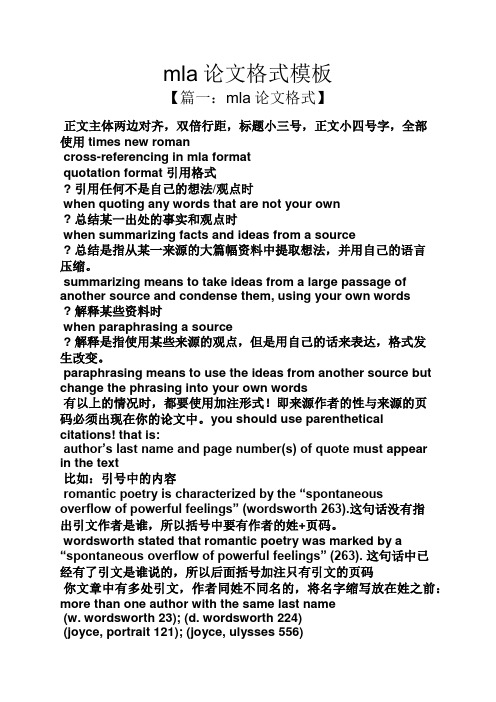
mla论文格式模板【篇一:mla论文格式】正文主体两边对齐,双倍行距,标题小三号,正文小四号字,全部使用times new romancross-referencing in mla formatquotation format 引用格式? 引用任何不是自己的想法/观点时when quoting any words that are not your own? 总结某一出处的事实和观点时when summarizing facts and ideas from a source? 总结是指从某一来源的大篇幅资料中提取想法,并用自己的语言压缩。
summarizing means to take ideas from a large passage of another source and condense them, using your own words? 解释某些资料时when paraphrasing a source? 解释是指使用某些来源的观点,但是用自己的话来表达,格式发生改变。
paraphrasing means to use the ideas from another source but change the phrasing into your own words有以上的情况时,都要使用加注形式!即来源作者的性与来源的页码必须出现在你的论文中。
you should use parentheticalcitations! that is:author’s last name and page number(s) of quote mu st appearin the text比如:引号中的内容romantic poetry is characterized by the “spontaneousoverflow of powerful feelings” (wordsworth 263).这句话没有指出引文作者是谁,所以括号中要有作者的姓+页码。
mla格式范文

mla格式范文MLA格式范文:身体健康的重要性在现代社会中,身体健康对于一个人的生活质量和幸福感至关重要。
然而,由于生活节奏加快、工作压力增大以及不良的生活习惯,越来越多的人面临着身体健康问题。
因此,我们需要重视并采取措施来维护和促进我们的身体健康。
首先,良好的身体健康可以提高我们的生活质量。
当我们身体健康时,我们能够更好地享受生活带来的乐趣。
我们可以尽情参与各种活动,如户外运动、旅行、社交等。
此外,身体健康也有助于提高我们的精神和情绪状态。
研究表明,锻炼能够释放内啡肽和多巴胺等神经递质,从而提高我们的情绪和心理健康。
其次,保持身体健康对我们的工作和学习也有积极的影响。
一个健康的身体意味着更高的能量水平和更好的注意力。
当我们身体健康时,我们能够更好地专注于工作和学习,并保持较高的工作效率。
此外,身体健康还能够提高我们的抵抗力,减少患病的机会,从而减少因病假而导致的工作或学业中断。
然而,要保持身体健康并非易事。
我们需要采取积极的生活方式和良好的生活习惯。
首先,定期锻炼是至关重要的。
每周进行适度的有氧运动和力量训练可以增强我们的肌肉和心肺功能,提高身体的整体健康水平。
其次,良好的饮食习惯也是必不可少的。
我们应该保证摄入足够的营养物质,并避免过多的高糖、高脂食物。
此外,充足的睡眠和压力管理也是保持身体健康的重要方面。
总之,身体健康对我们的生活质量和幸福感至关重要。
我们应该重视并采取措施来维护和促进我们的身体健康。
通过采取积极的生活方式和良好的生活习惯,我们能够享受更好的生活,并在工作和学习中取得更好的成绩。
只有拥有健康的身体,我们才能在生活中充分发挥我们的潜力。
- 1、下载文档前请自行甄别文档内容的完整性,平台不提供额外的编辑、内容补充、找答案等附加服务。
- 2、"仅部分预览"的文档,不可在线预览部分如存在完整性等问题,可反馈申请退款(可完整预览的文档不适用该条件!)。
- 3、如文档侵犯您的权益,请联系客服反馈,我们会尽快为您处理(人工客服工作时间:9:00-18:30)。
中文论文范文MLA格式关于XX论文mla格式问题首先,你的老师很可能不认为维基百科是一个可靠的资料,引用之前最好先问一下一般MLA引用句子就在引用部分外面加双引号就好了,句子的结尾要加一个in text citation,格式是(作者名字,页数)如果不是从书中引用,括号里的东西可能会不同。
Owl purdue网站上有很多例子题主可以看一下朋友写英文论文时,需要用MLA格式写作。
MLA格式有什么要求?特地找到关于MLA格式的规定,希望对朋友有帮助。
MLA(Modern Language Association)为美国现代语言协会制定的论文指导格式,在一般书写英语论文时应当使用MLA格式来保证学术著作的完整。
一、MLA简明论文格式(以下word格式可参用附加档已设定完成,套用即可)1. 内容分封面、正文、注释。
2. 规格:A4纸,计算机打字,横打,上下左右空4.5cm,标题与内文字距离0.5cm;字大小:照相打字15- 16级(Windows 文书软件10- 11pt),内文字请用细明或新细明体,标准行距(Windows 文书软件0.6- 0.7cm),25pp以内。
3. 横式(由左至右)写作。
4. 关键詷4-6个。
5. 提要300-500字。
6. 请用新式标点符号。
「」用于平常引号,《》用于书名,〈〉用于论文及篇名。
古籍之书名与篇名连用时,可省略篇名符号,如《史记?刺客列传》。
7. 中文正文用细明体,注脚用楷书。
8. 英文正文用Times New Roman; 章节用Arial。
9. 英文书名用Italic; 论文名用“”。
10. 独立引文每行低三格(楷书)。
11. 注释号码请用阿拉伯字数码之上标字(右上方),如9、25。
12. 标题编码层次:一、 (一) 1. (1)13. 征引书目编写方式:(1)中日文部分依作者姓名笔划排列A.专书B.期刊论文C.博、硕士论文(2)西文部分依作者姓名字母排列A.专书B.期刊论文C.博、硕士论文14. 不可使用“同上”、“同前引书”、“同前书”、“同前揭书”、“同注几引书”等。
15. 引用专书或论文,请依序注明作者、书名(或篇名)、出版项。
A.中日文专书:作者—书名—出版地点—出版公司—出版年分。
注文:彭明辉,《历史地理学与现代中国史学》(台北:东大图书公司,1995),38-45。
再引:彭明辉,《历史地理学与现代中国史学》,38-45。
书目:彭明辉,《历史地理学与现代中国史学》,台北:东大图书公司,1995。
B.中日文论文:作者—篇名—期刊卷期—出版项—年月—页码。
注文:彭明辉,〈由神明配置图看台湾民间信仰——以中和地区八座寺庙为中心〉,《新史学》,6. 4(台北,1995. 12): 45-87。
再引:彭明辉,〈由神明配置图看台湾民间信仰——以中和地区八座寺庙为中心〉,《新史学》,6. 4: 45-53。
书目:彭明辉,〈由神明配置图看台湾民间信仰——以中和地区八座寺庙为中心〉,《新史学》,6. 4 (台北,1995. 12): 45-87。
C.西文专书:作者—书名—出版地点—出版公司—出版年分。
例:注文:Samuel P. Huntington, Political Order in Changing Societies (New Havens: Yale University Press, 1968), 102-103.再引:Samuel P. Huntington, Political Order in Changing Societies, 102-103.书目:Huntington, Samuel P. Political Order in Changing Societies. New Havens: Yale University Press, 1968.D.西文论文:作者—篇名—期刊卷期—出版项—年月—页码。
例:注文:Hoyt Tillman, “A New Direction in Confucian Scholarship: Approaches to Examining the Differencesbetween Neo-Confucianism and Tao-hseh,” Philosophy East and West, 42. 3 (New York, July, 1992): 455-474.再引:Hoyt Tillman, “A New Direction in Confucian Scholarship: Approaches to Examining the Differences between Neo-Confucianism and Tao-hseh,” Philosophy East and West, 42. 3: 455- 474.书目:Tillman, Hoyt. “A New Direction in Confucian Scholarship: Approaches to Examining the Differences between Neo-Confucianism and Tao-hseh,” Philosophy East and West, 42. 3 (New York, July, 1992): 455-474.附注及引用文献第一类型历史引用一本书一位作者/两位作者/三位作者3.范文澜,《中国通史简编》(香港:南国出版社,1954),11。
范文澜,《中国通史简编》,香港:南国出版社,1954。
4.戴国辉、叶芸芸,《爱憎228—神话与史实》(台北:远流出版社,1992),11-20。
戴国辉、叶芸芸,《爱憎228—神话与史实》,台北:远流出版社,1992。
5.冉光荣、李绍明、周锡银,《羌族史》(成都:四川人民出版社,1984)。
冉光荣、李绍明、周锡银,《羌族史》,成都:四川人民出版社,1984。
6. David Lowenthal, The Past is a Foreign Country (London: Cambridge University Press, 1985), 23-25.Lowenthal, David. The Past is a Foreign Country. London: Cambridge University Press, 1985.7. James Fentress & Chris Wickham, Social Memory (Oxford: Blackwell Publishers, 1992), 24-26.Fentress, James & Chris Wickham. Social Memory. Oxford: Blackwell Publishers, 1992.多于三位作者/编者8.周大城等,《台湾自然地理》(台北:立人出版社,1994),21-40。
周大城等,《台湾自然地理》,台北:立人出版社,1994。
9. Elizabeth Tonkin et al, History and Ethnicity (London: Routledge, 1989), 30-40.Tonkin, Elizabeth et al. History and Ethnicity. London: Routledge, 1989.作者为一机构/多机构1.中央研究院近代史研究所,《口述历史—二二八事件专号》,3 (台北:中央研究院近代史研究所,1992),11-15。
中央研究院近代史研究所,《口述历史—二二八事件专号》,3,台北:中央研究院近代史研究所,1992。
2.吉林省文物工作队、榆树县博物馆,《吉林榆树县老河深鲜卑墓群》(北京:文物出版社,1990),11-20。
吉林省文物工作队、榆树县博物馆,《吉林榆树县老河深鲜卑墓群》,北京:文物出版社,1990。
作者为编者3.赵松侨编,《中国自然地理》(台北:地图出版社,1984),21-30。
赵松侨编,《中国自然地理》,台北:地图出版社,1984。
4. Eric Hobsbawm and Terence Ranger eds., The Invention of Tradition (Cambridge: Cambridge University Press, 1983), 11-15.Hobsbawm, Eric and Terence Ranger eds. The Invention of Tradition. Cambridge: Cambridge University Press, 1983.被翻译著作5.韦伯(Max Weber),《宗教社会学》,康乐、简惠美译(台北:远流出版公司,1991),131-32。
韦伯(Max Weber),《宗教社会学》,康乐、简惠美译,台北:远流出版公司,1991。
6. Maurice Halbwachs, On Collective Memory, ed. & trans. by Lewis A. Coser (Chicago: The University of Chicago Press, 1992), 101-22.Halbwachs, Maurice. On Collective Memory. Ed. & trans. by Lewis A. Coser. Chicago: The University of Chicago Press, 1992.多作者丛书中的一本3.黄清连,《黑金与黄金:基隆河上游地区矿业的发展与聚落的变迁》,「北县乡土与社会大系」之一(板桥:台北县立文化中心,1995),21-25。
黄清连,《黑金与黄金:基隆河上游地区矿业的发展与聚落的变迁》,「北县乡土与社会大系」之一,板桥:台北县立文化中心,1995。
单一作者丛书中的一本4.王国维,《观堂别集》,《海宁王忠悫公遗书》,第九册(无出版处,1927),23-25。
王国维,《观堂别集》,《海宁王忠悫公遗书》,第九册,无出版处,1927。
不同的版本罗振玉,《殷虚书契考释》,重印增订殷虚书契考释本(台北:艺文印书馆,1969),23-25。
罗振玉,《殷虚书契考释》,重印增订殷虚书契考释本,台北:艺文印书馆,1969。
7. Benedict Anderson, Imagined Communities, rev. edition (London: Verso Press, 1991), 121-25.Anderson, Benedict. Imagined Communities. Rev. edition. London: Verso Press, 1991.老书重印5.刘师培,《中国民族志》(台北:中国民族学会,1962),25-28。
